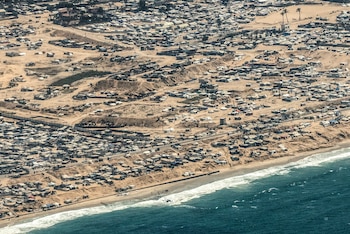
King Abdullah II Air Base, Jordan - Blocks and blocks of ruined buildings, dotted with vast tent encampments. Scenes of devastation where neighborhoods once stood.
The opportunity to travel on Wednesday on a Jordanian aid flight conducting airdrops over the Gaza Strip provided a rare opportunity to obtain low-altitude aerial views of the extent of the destruction and displacement in the territory.
Gaza has been closed to the foreign press since Israel launched its military operation in response to the Hamas attack on October 7, 2023, and aerial views have been limited mainly to satellite imagery, Israeli military photos, and drone footage of Gazan journalists and media workers; at least 186 of them have been killed, according to the Committee to Protect Journalists.

The images show the destructive impact of Israeli bombing that has damaged or destroyed much of Gaza, repeatedly displaced most of its population and left more than 60,000 dead, according to the Gaza Health Ministry, which does not distinguish between civilians and combatants.
The Israel Defense Forces claim they only target militants. They blame Hamas for civilian deaths, claiming the militants operate in populated areas. “IDF actions are based on military necessity and in accordance with international law,” the IDF stated Saturday.
Hamas fighters killed some 1,200 people, according to Israel, and took another 250 hostage in the 2023 attack. More than 450 Israeli soldiers have been killed in Gaza.
Journalists from Sky News and the BBC reporting from aid flights from Jordan this week said they were informed that Israel had banned filming Gaza from the air. The organizations did not specify how the directive was conveyed. Sky reported that they were told Israel could delay or cancel aid flights if its journalists filmed Gaza.
The IDF declined to comment.
A Washington Post photojournalist received no such instructions before boarding a Royal Jordanian Air Force flight on Wednesday. On a later flight Friday, a Jordanian crew member informed her that she was not allowed to film Gaza, only the airdrop.
The images shown here are from Wednesday, when two Jordanian C-130 transport planes, in cooperation with the United Arab Emirates Air Force, dropped more than 16 tons of food and infant formula over Gaza, with Israeli authorization. Most of the photographs were taken through the plane's windows, looking east toward Gaza City.

A close-up shows seven schools destroyed by Israeli strikes: al-Zahawi Boys' Preparatory School, Asdood Boys' Middle School, Abo Thar al-Ghafary School, Julis Boys' Middle School, al-Awda Primary School, Sarafand Boys' Preparatory School, and Samy al-Alamy Boys' School.
Tents for displaced people occupy schoolyards. Photos posted on Facebook a few days before the start of the war showed young students lining up there.

A solitary building on a plot of land occupied by displaced persons' tents is the El-Helou International Hotel, which houses a vast ballroom draped in gold fabric and lit by chandeliers. It was once a popular venue for weddings and meetings in northern Gaza City.

Rubble, collapsed buildings, and tent encampments occupy the site where the Maqoussi Mosque and the Ministry of Economy once stood. The mosque's dome collapses into its flattened roof. Next to the mosque stands the ruined facade of the Sheikh Radwan Health Center, a clinic destroyed during the war and run by the UN agency for Palestinian refugees.


A zoomed-in image shows the ruins of the Jabaliya refugee camp. The scene of fierce fighting between Hamas and the Israeli military in previous conflicts, Jabaliya was besieged by the Israeli military from October to December 2024. Food and water supplies, as well as access for civil defense and paramedics, were virtually denied, and large areas of the neighborhood were demolished.

Adel, the Royal Jordanian Air Force pilot who flew the aid drop mission, said the view of Gaza from the air “left me in shock.” Adel witnessed “increasing” destruction compared to the last time he flew over Gaza during the first round of airdrops last year, he added.
He withheld his last name because he was not authorized to speak publicly.
“Everyone who visits this area will be shocked,” he added. “We hope this war ends. We need to give them more and more food, because they are starving there.”

“It was very sad to see the Gaza Strip from above,” said Maher Halaseh, 36, a navigator with the Royal Jordanian Air Force who also participated in last year’s airdrops, on Friday. “Everything is different. There are no buildings, nothing. There are a lot of tents on the coast. I started seeing it when all the buildings were there. Now, there’s nothing. They’re dying there.”

A closer look reveals how hundreds of thousands of Gazans live, in makeshift tents erected anywhere, including on the beach in southern Gaza.

Humanitarian groups say the airdrops that resumed this week, while better than no aid, are far less efficient than sending aid overland. Aid organizations have called them a “last resort.” Instead, they have urged Israel to open land crossings and allow a large volume of trucks into Gaza. Israel says it is not restricting aid to Gaza.
Jordan has become a platform for airdrops, supported by governments in the region and Europe, in response to the growing famine.
Airdrops are not precisely guided and do not allow for organized distribution on the ground. In previous waves of airdrops, heavy aid boxes fatally crushed aid seekers and swept them into the sea, where they drowned while trying to reach the food, health officials reported.

